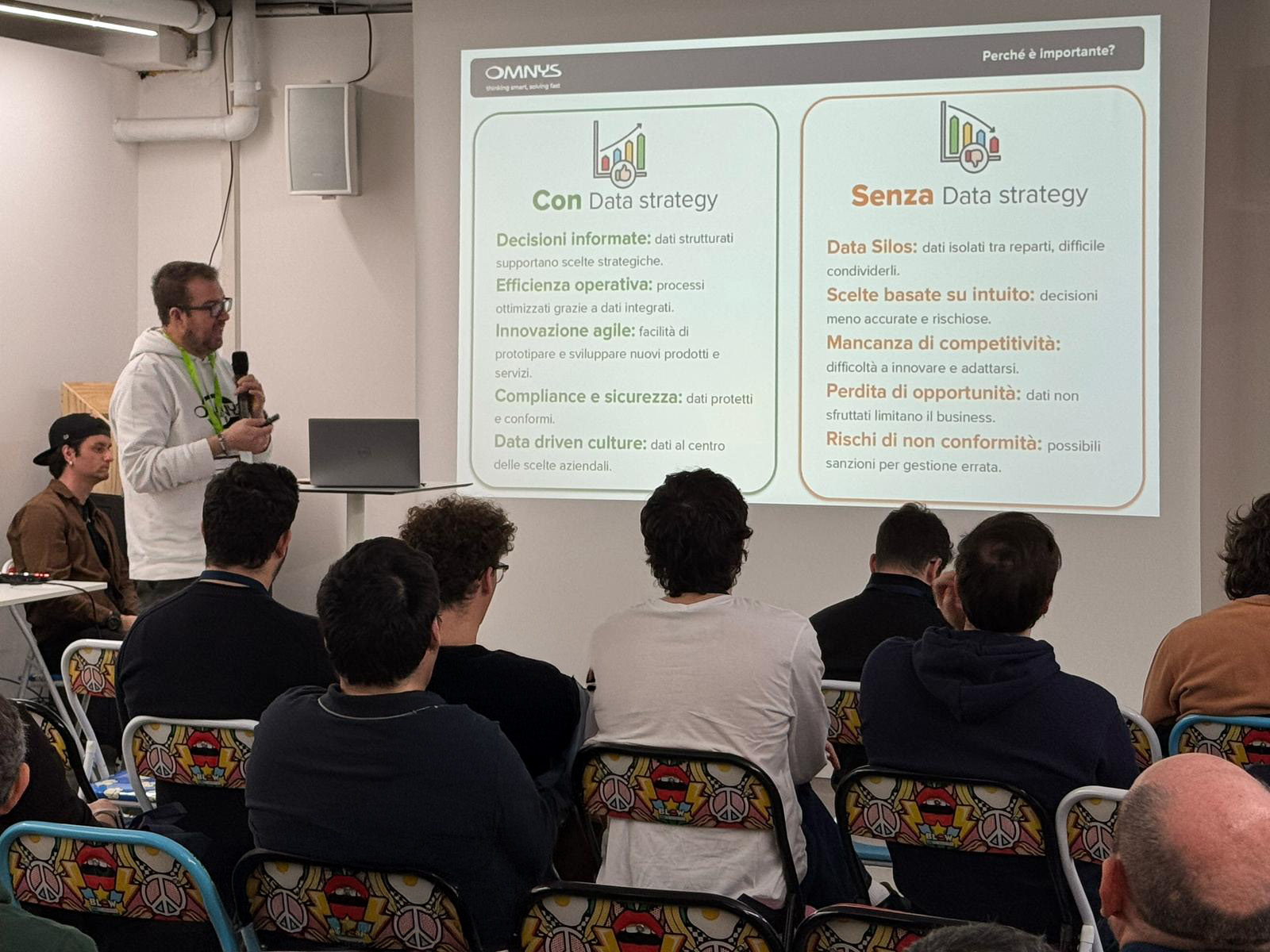Data is one of the most valuable assets for any company, but owning it is not enough: it's essential to know how to leverage it to create a real competitive advantage.
This is where a data strategy comes into play: a structured and strategic approach that allows you to govern, optimize, and transform your information assets into a tangible business asset.
Due to its importance, we chose to bring this topic to the AWS Community Day 2025, held on April 2 in Milan, with the talk “Data Strategy: How I Met Your Data” presented by the Omnys team, represented by Luca Fiscato, Manuel Vianello, and Filippo Fracca.
A special event to engage with other AWS community members and attend talks from high-profile European speakers. This edition brought together over 160 participants including professionals, partners, tech enthusiasts, and key figures like the AWS Heroes.
 Data Strategy: A Business Vision
Data Strategy: A Business Vision
As we’ve already emphasized, today a data strategy has become a central component of corporate strategies.
Why is it so crucial?
It's not just a collection of technological tools: it’s a true strategic business vision. It means defining a clear, structured plan to collect, organize, manage, store, and analyze data, transforming it into real business value.
In a cloud-native context, it becomes the key to fully exploiting advanced technologies like generative AI to optimize business processes and reduce operating costs. Many companies today possess massive amounts of data but don’t really know how to use it. An effective data strategy allows raw data to be transformed into useful information — and this is exactly where Omnys and AWS can play a fundamental role.
Let’s start with a core principle: to implement an effective data strategy, it’s essential to have scalable, secure, and highly reliable cloud infrastructure, and a data platform offers all these characteristics.
It’s a structured environment, based on cloud providers like AWS, where data is centralized, integrated, and prepared for analysis. At the core of every data platform lies the data lake — a flexible container capable of collecting heterogeneous data from sources like ERPs, CRMs, IoT sensors, document systems, and more.
A modern data lake must meet several essential requirements:
● Virtually unlimited storage capacity to effectively archive large volumes of data;
● High reliability guaranteed by solutions like Amazon S3, offering security and cost-efficiency;
● Advanced queryability that makes data easily accessible and usable, following the 6Vs principles (Volume, Variety, Velocity, Veracity, Value, Variability).
These initially unstructured data are managed via data ingestion services and transformed into a queryable asset ready to power advanced business intelligence, machine learning, and generative AI tools.

From Data to Vision: The Entire Ecosystem
Analyzing a company’s data ecosystem is crucial because it helps determine how to manage and select the most suitable services. Every decision is backed by mapping the available sources, guiding the assembly and integration of services required to aggregate, transform, and enhance data.
At this stage, each component is selected based on specific business needs with the goal of creating an optimized data platform that enables:
● Continuous and automated data acquisition;
● Organizing data into queryable and easily updatable structures;
● Visualizing key KPIs and metrics to monitor performance;
● Integrating AI models to add value and insights.
The ultimate goal is (once again!) to maximize the potential of data.
Next-Gen Technologies: Apache Iceberg and Beyond
At AWS Community Day, immersed in such a stimulating context, we chose to go further, exploring some of the most advanced frontier technologies offered by AWS, such as Apache Iceberg and S3 Table Bucket.
Apache Iceberg is a high-performance format designed for managing large-scale analytical tables. It brings the simplicity of SQL tables to data platforms, ensuring reliability, efficiency, and ease of use. It’s a true revolution for the data lake: enabling simple dataset modifications while improving performance and traceability. In a constantly evolving enterprise context, this is the ideal solution for agile, powerful, and governed data management.
S3 Table Bucket, on the other hand, is a logical architecture that allows data in Amazon S3 to be organized in tabular format, often using optimized formats like Parquet. This structure can be easily queried via services like AWS Athena, AWS Glue, or Apache Hive, making data access even more versatile.
Successful Case Studies by Omnys
In this context, we mention some companies like Clivet and Archiva Group, which have become successful AWS case studies, supported by us in managing large datasets from heterogeneous sources such as documents, enterprise systems, and IoT devices.
For each of these companies, we designed scalable, modular cloud architectures on AWS, with the aim of simplifying data management and enhancing the entire process. The result is a clear, centralized, and integrated view of the business, capable of enabling new strategic and operational opportunities.
Want to Build Your Data Platform on AWS?
We’ll say it again: Data Strategy is the key to turning data into a real competitive advantage. With a Data Platform built on AWS, every business can:
● Manage data in a structured and secure way;
● Optimize operational efficiency;
● Reduce operating costs;
● Prepare for the adoption of advanced technologies based on AI and machine learning.
If we’ve piqued your curiosity and you’d like to know more, contact us today!